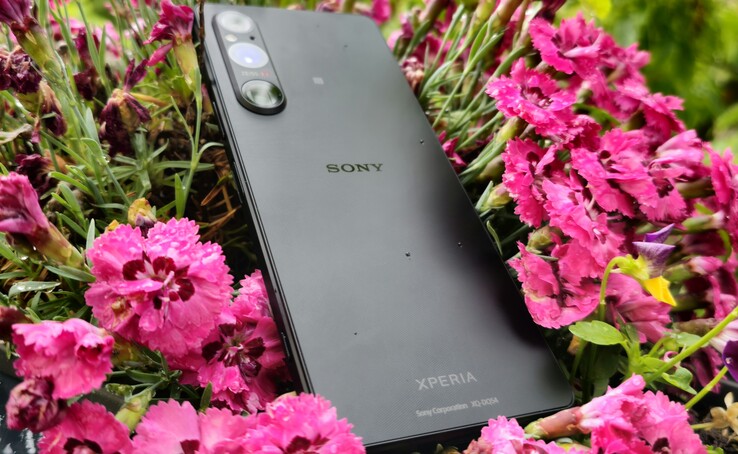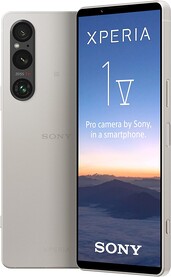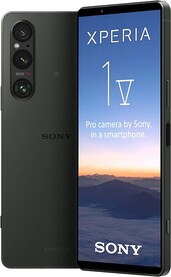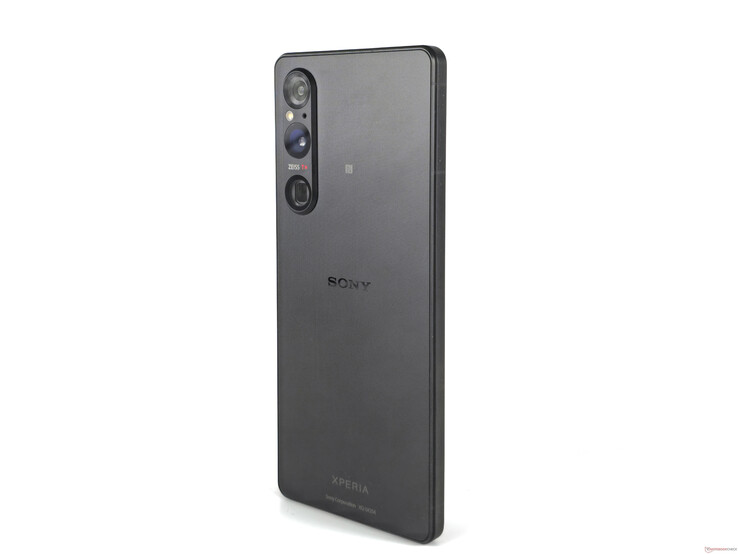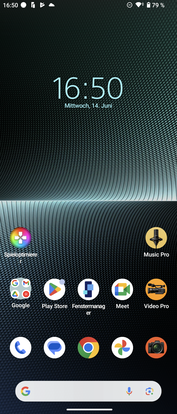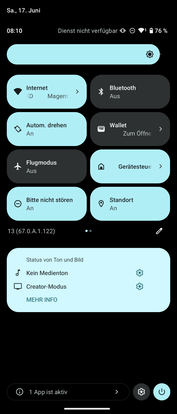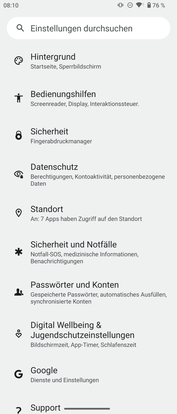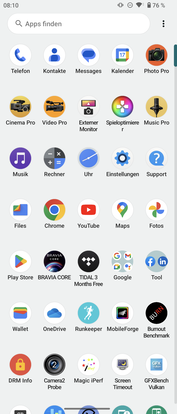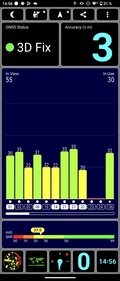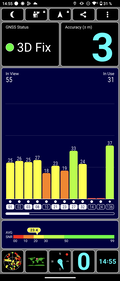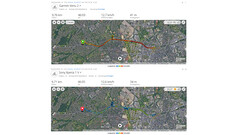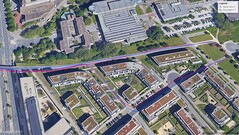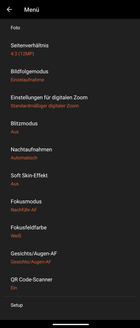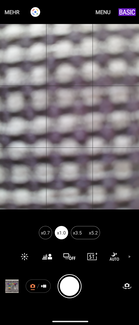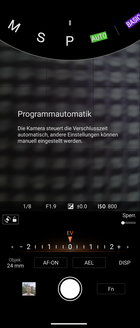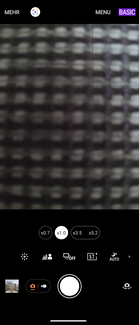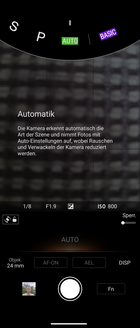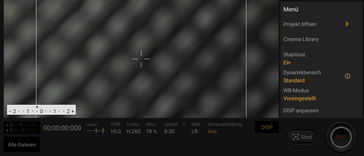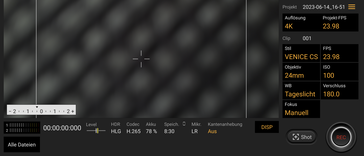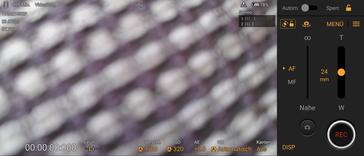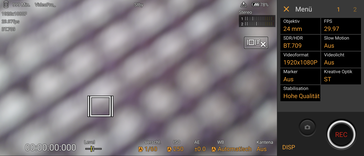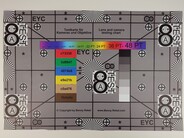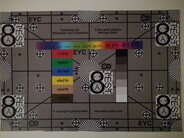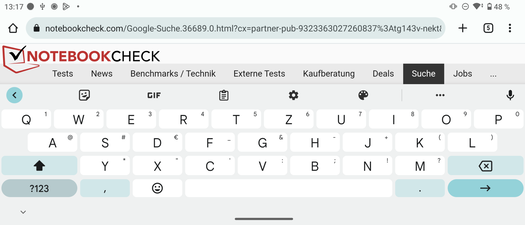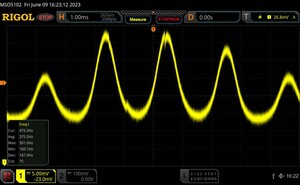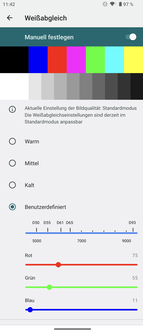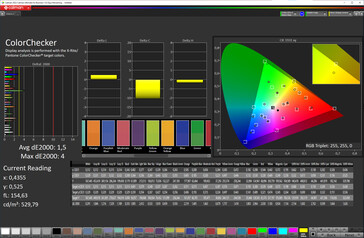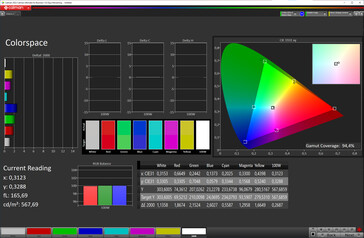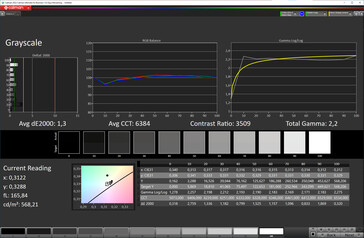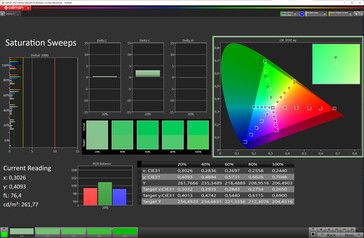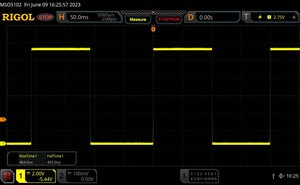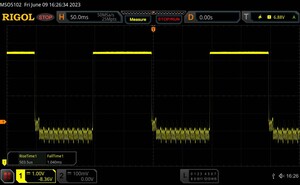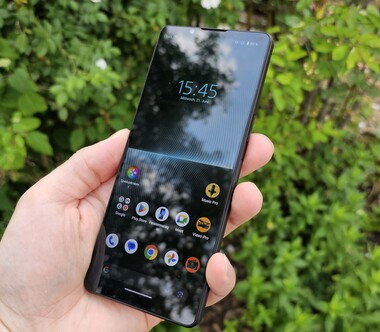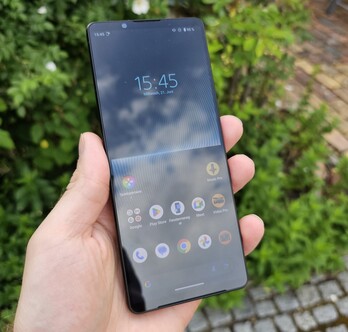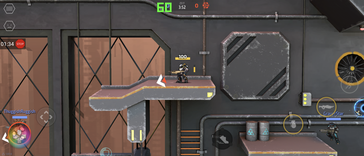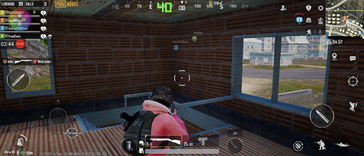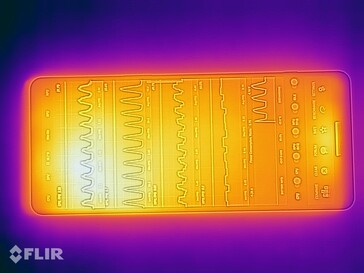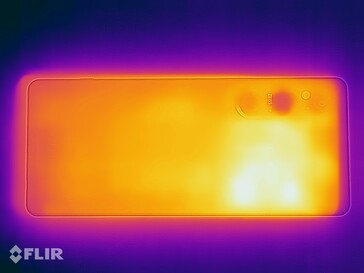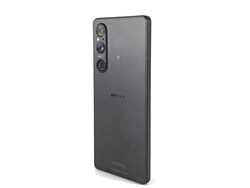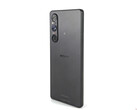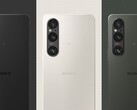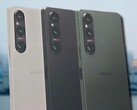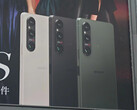Sony Xperia 1 V review - Premium smartphone with unrivaled equipment and Zeiss cameras
The at this point fifth generation of the Xperia 1 series is very similar to its predecessor in many points, but this isn't a negative. The 2023 camera flagship again offers an OLED display in the 21:9 format with a very high resolution, a headphone connection, and a microSD card reader. In addition, the dedicated camera trigger of the Xperia 1 V is also offered by hardly any other current smartphone.
As expected for a premium smartphone with an MSRP of 1,399 Euros (~$1,524), the Xperia 1 V uses a Snapdragon 8 Gen 2 and with 12 GB, a sufficient amount of working memory. According to Sony, the camera system was developed by the same engineers who are also responsible for the cameras of the Alpha 1 series. Aside from the main camera, it hardly differs from the predecessor. On the other hand, the new Exmor T sensor represents a promising improvement with its stacked technology. With the separated layers for the photodiode and phototransistor, the image sensor is supposed to offer a higher dynamic and lower noise level, particularly in low light conditions.
Possible Competitors in Comparison
Rating | Date | Model | Weight | Drive | Size | Resolution | Price |
|---|---|---|---|---|---|---|---|
| 89.9 % v7 (old) | 06 / 2023 | Sony Xperia 1 V SD 8 Gen 2, Adreno 740 | 187 g | 256 GB UFS 4.0 Flash | 6.50" | 3840x1644 | |
| 87.7 % v7 (old) | 08 / 2022 | Sony Xperia 1 IV SD 8 Gen 1, Adreno 730 | 185 g | 256 GB UFS 3.1 Flash | 6.50" | 3840x1644 | |
| 89.7 % v7 (old) | 06 / 2023 | Xiaomi 13 Ultra SD 8 Gen 2, Adreno 740 | 227 g | 512 GB UFS 4.0 Flash | 6.73" | 3200x1440 | |
| 91.1 % v7 (old) | 03 / 2023 | Samsung Galaxy S23 Ultra SD 8 Gen 2 for Galaxy, Adreno 740 | 233 g | 256 GB UFS 4.0 Flash | 6.80" | 3080x1440 | |
| 88.9 % v7 (old) | 05 / 2023 | Oppo Find X6 Pro SD 8 Gen 2, Adreno 740 | 218 g | 256 GB UFS 4.0 Flash | 6.82" | 3168x1440 |
Case - Sony smartphone with IP rating
For a current flagship smartphone, the Xperia 1 V turned out relatively light at 187 grams (~6.6 oz) despite the high battery capacity of 5,000 mAh, and with its tall 21:9 display it also turned out relatively slim at 71 millimeters (~2.7 in). The back cover, which is made of Gorilla Glass Victus, is available in three different colors: Black, Platinum, and Khaki, all of which have a rippled surface. Although this prevents fingerprints from becoming a problem, the particular structure makes the back cover appear more like plastic, which doesn't really give a high-quality impression.
The case of the Xperia 1 V is dust and waterproof according to the IP68 standard. The flat back makes it look more edgy and less ergonomic than a Galaxy S23 Ultra. However, the workmanship is first rate, and the keys sit comfortably tightly in the frame. As in the predecessor, you don't need to use a tool to open the SIM card slot.
The front of the Xperia 1 V is made of scratch-resistant Corning Gorilla Glass Victus 2, which transits flat into the metal frame. The latter inherited the V-shaped groves that we already know from the Xperia Pro-I, even if they are less pronounced on the Xperia 1 V. Due to the wider top and bottom display bezels, the ratio between the display and front of the device is only 84%, which is not as good. On the other hand, this also allowed Sony to forego a punch hole.
Equipment - Sony Xperia 1 V with 3.5 mm audio port
The Xperia 1 V is a real master in terms of its equipment. In addition to a 3.5 mm connection for audio, the Sony smartphone also offers NFC, Bluetooth 5.3, USB OTG including Miracast and Google Cast, as well as expandable internal storage via microSD card. The integrated card slot supports the current SDHC and SDXC standards up to 1 TB.
In addition to the wired display output to HDMI or DisplayPort connections, the fast 3.2 (Gen. 1) USB standard also supports compatibility to Sony Alpha cameras. We already know the function to use the smartphone as an external monitor for the Alpha camera from the Xperia Pro. In the Xperia 1 V, this feature is now implemented via the USB port instead of a mini-HDMI connection. In addition, the Sony flagship can be used for storage of photos and videos taken with the camera, and you can stream contents without a laptop of PC as long as you have an Internet connection. In our copy test using a connected M2.SSD external drive (Samsung 980 Pro), the USB reaches a rather mediocre transfer rates of 242 MB/s.
The UFS 4.0 storage offers a capacity of 256 GB, with only 216 GB of that being available to the user in the state of delivery. A version with 512 GB or even 1 TB is not available (in Germany).
microSD Card Reader
Our Angelbird V60 reference card is able to get some solid transfer rates in the Cross Platform Disk Test from the SD card slot of the Xperia 1 V. However, due to caching problems during sequential reading, we have to shorten our series of measurements slightly. While testing the copy speed in our JPEG image test, at about 19 MB/s, the transfer rate is slightly better than that of the predecessor, but some midrange smartphones can reach significantly higher speeds.
| SD Card Reader - average JPG Copy Test (av. of 3 runs) | |
| Samsung Galaxy A22 4G (Angelbird V60) | |
| Sony Xperia 1 V (Angelbird AV Pro V60) | |
| Sony Xperia 1 IV (Angelbird AV Pro V60) | |
Cross Platform Disk Test (CPDT)
Software - Sony smartphone with Android 13
During the time of our test, the operating system of the Xperia 1 V is based on Android 13 with the security patches at the level of April 2023. However, before the market start of the Sony smartphone, we still expect a day-one patch that includes a more current security package. The manufacturer overlays Android with its in-house Sony UI, which contains hardly any apps from third-party vendors in the state of delivery.
As before, Sony only promises to provide software updates for its flagship smartphone for two years, with security patches coming for a year longer. Considering the high MSRP of the Xperia 1 V, this is disappointing. In addition to Samsung as a reference in terms of update provisions in the Android area, almost all premium smartphones offer three major Android versions and five years of security patches as guaranteed updates.
Communication and GNSS - Sony Xperia 1 V with WiFi 6E
When using the WLAN at home, the Xperia 1 V doesn't include the current WiFi 7 like a Xiaomi 13 Ultra or Oppo Find X6 Pro. But with WiFi 6E, interested buyers of the Sony flagship don't have any reason to worry in terms of the connection speed. Using our Asus ROG Rapture GT-AXE11000 reference router, our test unit shows high and also fairly constant transfer rates. We measure a peak rate of almost 1,800 Mbps and still almost 1,000 Mbps in the 5 GHz net.
In addition to fast WLAN, the Sony flagship also uses the 5G standard, although it doesn't offer mmWave support. Furthermore, the Xperia 1 V also gives access to numerous LTE bands, with all the LTE frequencies important for German speaking countries being covered. The Xperia smartphone is also well-equipped for traveling abroad, for example to the USA.
| Networking | |
| Sony Xperia 1 V | |
| iperf3 receive AXE11000 | |
| iperf3 transmit AXE11000 | |
| iperf3 transmit AXE11000 6GHz | |
| iperf3 receive AXE11000 6GHz | |
| Sony Xperia 1 IV | |
| iperf3 receive AXE11000 | |
| iperf3 transmit AXE11000 | |
| iperf3 transmit AXE11000 6GHz | |
| iperf3 receive AXE11000 6GHz | |
| Xiaomi 13 Ultra | |
| iperf3 receive AXE11000 | |
| iperf3 transmit AXE11000 | |
| iperf3 transmit AXE11000 6GHz | |
| iperf3 receive AXE11000 6GHz | |
| Samsung Galaxy S23 Ultra | |
| iperf3 receive AXE11000 | |
| iperf3 transmit AXE11000 | |
| iperf3 transmit AXE11000 6GHz | |
| iperf3 receive AXE11000 6GHz | |
| Oppo Find X6 Pro | |
| iperf3 receive AXE11000 | |
| iperf3 transmit AXE11000 | |
| Average of class Smartphone | |
| iperf3 receive AXE11000 | |
| iperf3 transmit AXE11000 | |
| iperf3 transmit AXE11000 6GHz | |
| iperf3 receive AXE11000 6GHz | |
For locating its position, the Sony smartphone uses the main satellite systems only in the single band. In our test, it supports Beidou (B1), GPS (L1), Galileo (E1), and GLONASS (G1), and unfortunately there is no progress from the predecessor here. While the locating accuracy of the Xperia 1 V isn't perfect, the recorded route mostly corresponds to that of the Garmin Venu 2, which we use for comparison.
In the detail views, we notice some deviations of the GPS recordings mostly when changing the direction. However, the inaccuracies in the route recording are minor and hardly worth mentioning. The location determination also succeeds very quickly and with an accuracy of about 3 meters (~10 ft), even indoors.
Locating comparison: Sony Xperia 1 V vs. Garmin Venu 2
Phone Functions and Voice Quality - Sony smartphone with VoLTE
The voice quality of the Xperia 1 V is at a very good level, allowing for easily understandable communication using either the earpiece or the speaker. Our conversation partners also attest the Sony flagship with clean voice transfer and attractive suppression of other noises.
VoLTE and WLAN calls as well as dual-SIM are supported, but the 5G standard is limited to a single SIM slot. Optionally, you can either insert two Nano-SIM cards or use an eSIM instead of a physical SIM card.
Cameras - Sony Xperia 1 V with 52 MP
While the Xperia 1 V doesn't deliver a completely new camera system compared to its predecessor, the new sensor technology of the main camera still promises an improved low-light quality. Sony remains true to its design, using only a section of the new Exmor T in the 1/1.35-inch format similar to the Xperia Pro-I, which means that the resolution of the sensor is reduced from the native 52 MP to 48 MP.
The sensor, which according to rumors is called "IMX888," is combined with Zeiss lenses together with T* coating, which is supposed to ensure maximum translucence and low sensitivity to reflections. It possesses a 24 mm (~0.94 in) equivalent focal length. Our test pictures are taken with the automatic mode of the camera software. Theoretically, the image quality can still be optimized using the very extensive setting options. Known Alpha camera features such as eye autofocus with object tracking in real-time are included again, and the burst shots feature was increased from 20 to 30 fps in the Xperia 1 V.
In dark surroundings, the pictures taken with the Exmor T sensor are significantly better illuminated than they were in the Xperia 1 IV with the IMX838, and the noise level is also reduced. On the other hand, the level of sharpness of close objects fails to convince us both at night and with daylight. In addition, some grainy structures can be noticed in dark areas already at optimal light conditions. However, the new camera still offers the potential for very good recordings, even without individual finetuning.
The specialty of the Sony flagships are the variable periscope lenses with lossless zoom between 85 mm and 125 mm (~3.3 - 4.9 in). Behind the variable tele lens is an optically stabilized sensor in the 1/3.5-inch format that can be adjusted variably between zoom levels of 3.5x and 5.2x. The results show some slight improvement compared to those from the predecessor, but we still would have liked a bit more sharpness and details from an optical zoom. But since the tele camera uses the same hardware as that in the Xperia 1 IV, we didn't expect any large jumps in quality either.
The same goes for the ultrawide angle lens with an equivalent focal length of 16 mm (~0.63 in). The recordings show a solid level of sharpness and many details, but the photos still appear slightly noisy even during the day. The low dynamic and a few image artifacts with the ultrawide angle camera also don't speak for the Xperia 1 V compared to an Oppo Find X6 Pro.
When recording videos, the Sony flagship is able to score again. Not only does the Xperia 1 V support 120 frames per second in UHD recordings with all three camera lenses, but it also offers the known S Cinetone image profile for recordings with a "cinema" look. For YouTube scenes, there are also a product presentation function and some new live streaming functions. Besides the classic stereo microphones for surrounding noises, the Xperia 1 V also includes an additional microphone for voice recordings. On the other hand, the Sony flagship doesn't support recording videos in 8K resolution.
Image comparison
Choose a scene and navigate within the first image. One click changes the position on touchscreens. One click on the zoomed-in image opens the original in a new window. The first image shows the scaled photograph of the test device.
WeitwinkelWeitwinkelUltraweitwinkelLow LightZoom 5xWe look at the color accuracy of the new Sony sensor in the main camera in more detail under controlled light conditions. The measured deviations to the reference colors are free from any real outliers (>15), and most colors are reproduced accurately by the Xperia 1 V. However, the white balance and the grayscale don't match very well.
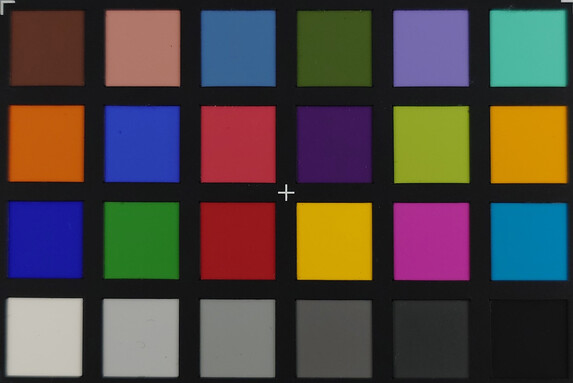
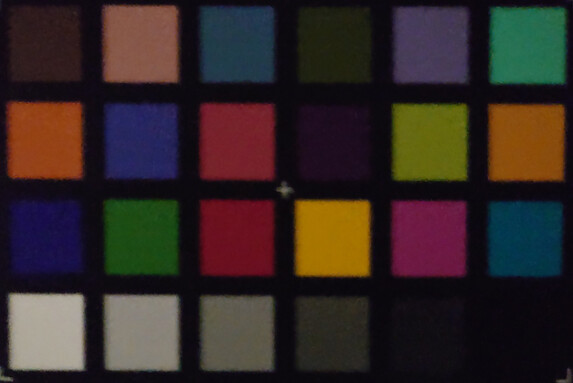
Accessories and Warranty - Sony smartphone without a charger
Sony not only leaves out a corresponding 30-Watt charger with its flagship smartphone, but the box of the Xperia 1 V includes neither a USB cable, nor any info material. However, the Japanese manufacturer optionally offers a lot of interesting accessories. For example, there is an accessory that turns the Xperia 1 V into a vlogging machine.
Sony offers a 24-month warranty for its smartphone in Germany.
Input Devices and Operation - Sony smartphone without Face Unlock
The Xperia 1 V offers a capacitive touchscreen that uses a scan rate of 240 Hz, quickly and reliably implementing inputs. The vibration motor delivers a comfortable haptic feedback but feels less precise than that of the Galaxy S23 Ultra or Xiaomi 13 Ultra.
The display in the wide 21:9 format attractively ensures that movies don't have any bars on top and bottom, but those who are interested in the Sony flagship should also be aware that a lot of video content, for example on YouTube, is produced in the 16:9 format. This will either cause such video content to be cropped or to be accompanied by wide black bars on the sides.
The capacitive fingerprint sensor in the frame of the Xperia smartphone recognizes the user reliably and unlocks the display at an attractive speed. However, a less secure 2D face recognition is not available.
Display - Sony Xperia 1 V with a high resolution
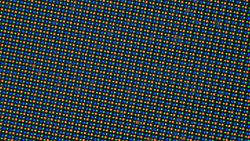
The Xperia 1 V has a large 6.5-inch OLED display with a 120 Hz refresh rate and a maximum resolution of 3,840 x 1,644 pixels, resulting in an enormously high pixel density of 643 ppi. Those who don't need a high refresh rate of 120 Hz additionally have the option to let the system automatically adjust it to 60 Hz. The Xperia 1 V doesn't offer a dynamic adjustment like in an LTPO panel.
The brightness of the HDR certified panel is very good with an active brightness sensor, but competitors such as the Galaxy S23 Ultra or Xiaomi 13 Ultra can get even significantly brighter. However, with an even distribution of light and dark areas (APL18), the OLED panel can get considerably brighter at up to 1,566 cd/m².
The OLED typical flickering ranges variably around 376 Hz, but the periods are fairly constant. We don't find a DC dimming mode in the setting menus.
| |||||||||||||||||||||||||
Brightness Distribution: 96 %
Center on Battery: 934 cd/m²
Contrast: ∞:1 (Black: 0 cd/m²)
ΔE ColorChecker Calman: 1.5 | ∀{0.5-29.43 Ø4.77}
ΔE Greyscale Calman: 1.3 | ∀{0.09-98 Ø5}
99.8% sRGB (Calman 2D)
Gamma: 2.2
CCT: 6384 K
| Sony Xperia 1 V AMOLED, 3840x1644, 6.5" | Sony Xperia 1 IV OLED, 3840x1644, 6.5" | Xiaomi 13 Ultra AMOLED, 3200x1440, 6.7" | Samsung Galaxy S23 Ultra Dynamic AMOLED 2x, 3080x1440, 6.8" | Oppo Find X6 Pro AMOLED, 3168x1440, 6.8" | |
|---|---|---|---|---|---|
| Screen | 11% | 14% | -14% | 13% | |
| Brightness middle (cd/m²) | 934 | 890 -5% | 1357 45% | 1117 20% | 1109 19% |
| Brightness (cd/m²) | 948 | 897 -5% | 1340 41% | 1133 20% | 1190 26% |
| Brightness Distribution (%) | 96 | 97 1% | 89 -7% | 97 1% | 91 -5% |
| Black Level * (cd/m²) | |||||
| Colorchecker dE 2000 * | 1.5 | 0.9 40% | 1.1 27% | 2.2 -47% | 1.3 13% |
| Colorchecker dE 2000 max. * | 4 | 2.4 40% | 2.7 32% | 3.9 2% | 2.2 45% |
| Greyscale dE 2000 * | 1.3 | 1.4 -8% | 2 -54% | 2.3 -77% | 1.6 -23% |
| Gamma | 2.2 100% | 2.21 100% | 2.2 100% | 2.37 93% | 2.23 99% |
| CCT | 6384 102% | 6320 103% | 6366 102% | 6572 99% | 6571 99% |
* ... smaller is better
Screen Flickering / PWM (Pulse-Width Modulation)
| Screen flickering / PWM detected | 376 Hz | ||
The display backlight flickers at 376 Hz (worst case, e.g., utilizing PWM) . The frequency of 376 Hz is relatively high, so most users sensitive to PWM should not notice any flickering. However, there are reports that some users are still sensitive to PWM at 500 Hz and above, so be aware. In comparison: 53 % of all tested devices do not use PWM to dim the display. If PWM was detected, an average of 8083 (minimum: 5 - maximum: 343500) Hz was measured. | |||
Measurement series with fixed zoom level and different brightness settings
We evaluate the color calibration of the OLED panel with the Calman analysis software and a photo spectrometer. The Standard profile targets the larger DCI-P3 color space, covering it almost completely. We see only very low deviations in the colors and grayscale here. Visible differences, if any, can only be detected with blue and red colors.
In addition, the Sony UI of the Xperia 1 V also offers a "Creator Mode" that is compatible with the large BT.2020 color space and 10-bit colors. In the Standard mode, you can also use the BT.2020 color scale for individually configurable apps. Compared to other standards such as sRGB, a significantly larger segment of the color spectrum that humans can perceive is then supported. Both modes allow for a manual white balance adjustment.
Display Response Times
| ↔ Response Time Black to White | ||
|---|---|---|
| 0.93 ms ... rise ↗ and fall ↘ combined | ↗ 0.464 ms rise | |
| ↘ 0.465 ms fall | ||
| The screen shows very fast response rates in our tests and should be very well suited for fast-paced gaming. In comparison, all tested devices range from 0.1 (minimum) to 240 (maximum) ms. » 3 % of all devices are better. This means that the measured response time is better than the average of all tested devices (20.2 ms). | ||
| ↔ Response Time 50% Grey to 80% Grey | ||
| 1.54 ms ... rise ↗ and fall ↘ combined | ↗ 0.5035 ms rise | |
| ↘ 1.04 ms fall | ||
| The screen shows very fast response rates in our tests and should be very well suited for fast-paced gaming. In comparison, all tested devices range from 0.165 (minimum) to 636 (maximum) ms. » 6 % of all devices are better. This means that the measured response time is better than the average of all tested devices (31.6 ms). | ||
Outdoors, the Xperia 1 V leaves a strong impression, possessing sufficient brightness reserves to deal with most light situations. There are also hardly any reflections on the Gorilla Glass Victus 2 surface that might hinder reading the contents of the OLED panel.
The viewing angle stability is also very good, and you only notice a loss in brightness from very steep viewing angles.
Performance - Sony smartphone with a Qualcomm SoC
The Xperia 1 V gets its performance from a fast Snapdragon 8 Gen 2 that presents itself well in some benchmarks. Due to problems when installing some apps including PlayStore apps and some apk files, we are unable to provide the usual amount of benchmark results. If this changes with the day-one patch, we will add those results.
In everyday usage, the Xperia 1 V offers a very high performance, and we almost don't see any stutters or delays at all when using the smartphone. However, the pure CPU performance turns out surprisingly low in Geekbench 6, and particularly in the multicore tests, the values of the Sony flagship turn out significantly lower than those of a Xiaomi 13 Ultra.
In the graphics tests of GFXBench, the Xperia 1 V with the Adreno 740 produces significantly lower values than a Samsung Galaxy S23 Ultra or Xiaomi 13 Ultra. We expected that the 4K panel would lead to lower onscreen results, but the tests also reveal some large differences in the offscreen values. The heat development and a lack of driver support of the Sony flagship might have a negative influence here.
GFXBench 3.0: on screen Manhattan Onscreen OGL | 1920x1080 1080p Manhattan Offscreen
GFXBench 3.1: on screen Manhattan ES 3.1 Onscreen | 1920x1080 Manhattan ES 3.1 Offscreen
GFXBench: on screen Car Chase Onscreen | 1920x1080 Car Chase Offscreen | on screen Aztec Ruins High Tier Onscreen | 2560x1440 Aztec Ruins High Tier Offscreen | on screen Aztec Ruins Normal Tier Onscreen | 1920x1080 Aztec Ruins Normal Tier Offscreen | 3840x2160 4K Aztec Ruins High Tier Offscreen
| GFXBench (DX / GLBenchmark) 2.7 / T-Rex Onscreen | |
| Samsung Galaxy S23 Ultra | |
| Xiaomi 13 Ultra | |
| Sony Xperia 1 V | |
| Sony Xperia 1 IV | |
| Oppo Find X6 Pro | |
| GFXBench (DX / GLBenchmark) 2.7 / T-Rex Offscreen | |
| Samsung Galaxy S23 Ultra | |
| Xiaomi 13 Ultra | |
| Oppo Find X6 Pro | |
| Sony Xperia 1 IV | |
| Sony Xperia 1 V | |
| GFXBench 3.0 / Manhattan Onscreen OGL | |
| Xiaomi 13 Ultra | |
| Samsung Galaxy S23 Ultra | |
| Sony Xperia 1 V | |
| Sony Xperia 1 IV | |
| Oppo Find X6 Pro | |
| GFXBench 3.0 / 1080p Manhattan Offscreen | |
| Xiaomi 13 Ultra | |
| Samsung Galaxy S23 Ultra | |
| Oppo Find X6 Pro | |
| Sony Xperia 1 IV | |
| Sony Xperia 1 V | |
| GFXBench 3.1 / Manhattan ES 3.1 Onscreen | |
| Xiaomi 13 Ultra | |
| Samsung Galaxy S23 Ultra | |
| Sony Xperia 1 V | |
| Sony Xperia 1 IV | |
| Oppo Find X6 Pro | |
| GFXBench 3.1 / Manhattan ES 3.1 Offscreen | |
| Xiaomi 13 Ultra | |
| Samsung Galaxy S23 Ultra | |
| Oppo Find X6 Pro | |
| Sony Xperia 1 IV | |
| Sony Xperia 1 V | |
| GFXBench / Car Chase Onscreen | |
| Sony Xperia 1 V | |
| Samsung Galaxy S23 Ultra | |
| Xiaomi 13 Ultra | |
| Oppo Find X6 Pro | |
| Sony Xperia 1 IV | |
| GFXBench / Car Chase Offscreen | |
| Oppo Find X6 Pro | |
| Xiaomi 13 Ultra | |
| Samsung Galaxy S23 Ultra | |
| Sony Xperia 1 V | |
| Sony Xperia 1 IV | |
| GFXBench / Aztec Ruins High Tier Onscreen | |
| Sony Xperia 1 V | |
| Samsung Galaxy S23 Ultra | |
| Oppo Find X6 Pro | |
| Sony Xperia 1 IV | |
| Xiaomi 13 Ultra | |
| GFXBench / Aztec Ruins High Tier Offscreen | |
| Samsung Galaxy S23 Ultra | |
| Xiaomi 13 Ultra | |
| Oppo Find X6 Pro | |
| Sony Xperia 1 IV | |
| Sony Xperia 1 V | |
| GFXBench / Aztec Ruins Normal Tier Onscreen | |
| Samsung Galaxy S23 Ultra | |
| Xiaomi 13 Ultra | |
| Oppo Find X6 Pro | |
| Sony Xperia 1 IV | |
| Sony Xperia 1 V | |
| GFXBench / Aztec Ruins Normal Tier Offscreen | |
| Samsung Galaxy S23 Ultra | |
| Xiaomi 13 Ultra | |
| Oppo Find X6 Pro | |
| Sony Xperia 1 V | |
| Sony Xperia 1 IV | |
| GFXBench / 4K Aztec Ruins High Tier Offscreen | |
| Samsung Galaxy S23 Ultra | |
| Sony Xperia 1 V | |
| Xiaomi 13 Ultra | |
| Oppo Find X6 Pro | |
| Sony Xperia 1 IV | |
The browser performance of the Xperia 1 V is very good, and surfing the web is very fast. Although the Sony smartphone achieves top values in some tests of our benchmark package, it is still surpassed overall by a Xiaomi 13 Ultra.
| Jetstream 2 - 2.0 Total Score | |
| Xiaomi 13 Ultra (Chrome 113) | |
| Samsung Galaxy S23 Ultra (Chrome 109) | |
| Oppo Find X6 Pro (Chrome 113) | |
| Average of class Smartphone (23.8 - 387, n=149, last 2 years) | |
| Sony Xperia 1 V (Chrome 114) | |
| Average Qualcomm Snapdragon 8 Gen 2 (62.7 - 179.2, n=23) | |
| Sony Xperia 1 IV (Chrome 103) | |
| Speedometer 2.0 - Result 2.0 | |
| Average of class Smartphone (15.2 - 643, n=120, last 2 years) | |
| Sony Xperia 1 V (Chrome 114) | |
| Xiaomi 13 Ultra (Chrome 113) | |
| Oppo Find X6 Pro (Chrome 113) | |
| Samsung Galaxy S23 Ultra (Chrome 109) | |
| Average Qualcomm Snapdragon 8 Gen 2 (62.9 - 225, n=18) | |
| Sony Xperia 1 IV (Chrome 103) | |
| WebXPRT 4 - Overall | |
| Sony Xperia 1 V (Chrome 114) | |
| Average of class Smartphone (27 - 306, n=144, last 2 years) | |
| Oppo Find X6 Pro (Chrome 113) | |
| Samsung Galaxy S23 Ultra (Chrome 110) | |
| Xiaomi 13 Ultra (Chrome 113) | |
| Average Qualcomm Snapdragon 8 Gen 2 (28 - 183, n=22) | |
| Sony Xperia 1 IV (Chrome 103) | |
| WebXPRT 3 - Overall | |
| Sony Xperia 1 V | |
| Oppo Find X6 Pro (Chrome 113) | |
| Xiaomi 13 Ultra (Chrome 113) | |
| Average Qualcomm Snapdragon 8 Gen 2 (115 - 238, n=11) | |
| Average of class Smartphone (38 - 380, n=30, last 2 years) | |
| Sony Xperia 1 IV (Chrome 103) | |
| Octane V2 - Total Score | |
| Xiaomi 13 Ultra (Chrome 113) | |
| Sony Xperia 1 V (Chrome 114) | |
| Samsung Galaxy S23 Ultra (Chrome 109) | |
| Oppo Find X6 Pro (Chrome 113) | |
| Average of class Smartphone (2228 - 126661, n=195, last 2 years) | |
| Sony Xperia 1 IV (Chrome 103) | |
| Average Qualcomm Snapdragon 8 Gen 2 (19870 - 65418, n=25) | |
| Mozilla Kraken 1.1 - Total | |
| Average of class Smartphone (257 - 28190, n=155, last 2 years) | |
| Average Qualcomm Snapdragon 8 Gen 2 (602 - 1837, n=22) | |
| Oppo Find X6 Pro (Chrome 113) | |
| Sony Xperia 1 IV (Chrome 103) | |
| Sony Xperia 1 V (Chrome 114) | |
| Samsung Galaxy S23 Ultra (Chrome 109) | |
| Xiaomi 13 Ultra (Chrome 113) | |
* ... smaller is better
Games - Sony smartphone only reaches 60 fps
Even though the Xperia 1 V is not a gaming smartphone, the Japanese manufacturer has still equipped its premium smartphone with some nice features for ambitioned gamers. A "Game Optimizer" that automatically starts when opening a game and then remains visible as a pop-up control panel offers quick access to settings and the device status. You can deactivate notifications or incoming calls here, for example. Some other options, such as the Low Gamma Raiser that optimizes image details in dark areas, allowing you to easier see enemies hidden in the dark, or the Audio Equalizer to emphasize noises such as steps or shots, should also represent some useful features for gamers.
The Adreno 740 in the Xperia 1 V is nominally one of the most powerful graphics units available for Android smartphones at the time of this test. However, Sony still limits its flagship to 60 fps, so that real HFR gaming won't be possible. Using the GameBench app, we analyze the PUBG Mobile and Armajet games in more detail. While the gaming experience is limited to 40 fps in the shooter using the Ultra-HD setting, we see some higher frame rates using the lower detail settings. But we also only measure 60 fps when we have activated the 90 fps option. The same is also the case for the arena shooter from Super Bit Machine.
Emissions - The Sony Xperia 1 V doesn't stay cool
Temperatures
While the surface temperatures remain low during idle operation, we measure peak values of more than 44 °C (111 °F) under constant load. However, for comparisons to older temperature measurements, we should also mention that we now use the Burnout benchmark to determine the temperatures under load instead of the stability test. An exact comparison is therefore not possible anymore. On the other hand, the Xperia 1 V still gets less warm than a Xiaomi 13 Ultra or Oppo Find X6 Pro.
(±) The maximum temperature on the upper side is 44.6 °C / 112 F, compared to the average of 35.2 °C / 95 F, ranging from 21.9 to 247 °C for the class Smartphone.
(±) The bottom heats up to a maximum of 44.3 °C / 112 F, compared to the average of 34 °C / 93 F
(+) In idle usage, the average temperature for the upper side is 29.1 °C / 84 F, compared to the device average of 32.9 °C / 91 F.
Speakers
The two Dolby Atmos certified speakers of the Xperia 1 V allow playing audio content at a very loud volume and sound balanced overall. But the lower frequency range is a bit weak, and bass is hardly included in the sound spectrum. Not only can the 360 Reality Audio feature of the Sony flagship be used with wired or wireless headphones but thanks to the hardware decoding, also with the stereo speakers – at least in some selected services (TIDAL and nugs.net).
Some more apps for 360 Reality Audio such as Amazon Music or Deezer are available for headphones, which can be connected wirelessly via Bluetooth 5.3 or wired via the 3.5-mm audio port. In our measurement, the audio port delivers low-noise output at 84 dBFS. In terms of Bluetooth codecs, with support for SBC, AAC, aptX, aptX HD, aptX Adaptiv, aptX TWS+, LHDC, and LDAC, nothing else remains to be desired.
Sony Xperia 1 V audio analysis
(+) | speakers can play relatively loud (90.6 dB)
Bass 100 - 315 Hz
(-) | nearly no bass - on average 23% lower than median
(+) | bass is linear (5.4% delta to prev. frequency)
Mids 400 - 2000 Hz
(+) | balanced mids - only 3.6% away from median
(+) | mids are linear (4.9% delta to prev. frequency)
Highs 2 - 16 kHz
(+) | balanced highs - only 3.2% away from median
(+) | highs are linear (3.5% delta to prev. frequency)
Overall 100 - 16.000 Hz
(±) | linearity of overall sound is average (15.4% difference to median)
Compared to same class
» 4% of all tested devices in this class were better, 3% similar, 94% worse
» The best had a delta of 11%, average was 35%, worst was 134%
Compared to all devices tested
» 22% of all tested devices were better, 4% similar, 74% worse
» The best had a delta of 4%, average was 24%, worst was 134%
Oppo Find X6 Pro audio analysis
(+) | speakers can play relatively loud (89.4 dB)
Bass 100 - 315 Hz
(-) | nearly no bass - on average 24.7% lower than median
(±) | linearity of bass is average (10.9% delta to prev. frequency)
Mids 400 - 2000 Hz
(+) | balanced mids - only 4% away from median
(+) | mids are linear (4% delta to prev. frequency)
Highs 2 - 16 kHz
(±) | higher highs - on average 5% higher than median
(+) | highs are linear (3.1% delta to prev. frequency)
Overall 100 - 16.000 Hz
(±) | linearity of overall sound is average (18.5% difference to median)
Compared to same class
» 20% of all tested devices in this class were better, 9% similar, 71% worse
» The best had a delta of 11%, average was 35%, worst was 134%
Compared to all devices tested
» 41% of all tested devices were better, 8% similar, 51% worse
» The best had a delta of 4%, average was 24%, worst was 134%
Battery Life - Sony smartphone only charges at 30 watts
Power Consumption
The 5,000 mAh battery can only be charged at a maximum of 30 watts using USB PD 3.0. A corresponding power bank (PD 3.0, 100 watts) is able to completely recharge the Xperia 1 V in about 100 minutes. Wireless charging at a maximum of 15 watts using an optional Qi certified charger is also supported.
The power consumption isn't particularly efficient, neither during idle operation, nor under load. Please note that our Geekbench measurement was created using the current version (6.0.1) instead of Geekbench 5.4 that we usually use.
| Off / Standby | |
| Idle | |
| Load |
|
Key:
min: | |
| Sony Xperia 1 V 5000 mAh | Sony Xperia 1 IV 5000 mAh | Xiaomi 13 Ultra 5000 mAh | Samsung Galaxy S23 Ultra 5000 mAh | Oppo Find X6 Pro 5000 mAh | Average Qualcomm Snapdragon 8 Gen 2 | Average of class Smartphone | |
|---|---|---|---|---|---|---|---|
| Power Consumption | 25% | 40% | 45% | 39% | 16% | 23% | |
| Idle Minimum * (Watt) | 1.52 | 1.06 30% | 0.86 43% | 0.9 41% | 0.87 43% | 1.036 ? 32% | 0.847 ? 44% |
| Idle Average * (Watt) | 2.16 | 1.71 21% | 1.53 29% | 1.05 51% | 1.6 26% | 1.766 ? 18% | 1.446 ? 33% |
| Idle Maximum * (Watt) | 2.2 | 1.89 14% | 1.64 25% | 1.1 50% | 1.68 24% | 1.94 ? 12% | 1.63 ? 26% |
| Load Average * (Watt) | 7.85 | 4.99 36% | 3.12 60% | 3.99 49% | 3.65 54% | 7.22 ? 8% | 6.95 ? 11% |
| Load Maximum * (Watt) | 11.57 | 8.91 23% | 6.5 44% | 7.82 32% | 6.14 47% | 10.4 ? 10% | 11.3 ? 2% |
* ... smaller is better
Power Consumption: Geekbench (150 cd/m²)
Power Consumption: GFXBench (150 cd/m²)
Battery Life
With the permanent 120 Hz and very high resolution of the display, the battery life of the Xperia 1 V doesn't turn out particularly long. A display brightness adjusted to 150 cd/m² allows us to compare the battery life of various devices.
In our realistic WLAN test, the Sony flagship manages to last for 12.5 hours, and when playing an endless video loop, 14 hours with a deactivated WLAN module, which also speaks for a well-optimized communication module. The more efficient SoC results in an advantage of 35% compared to the predecessor generation, but compared to the LTPO competitors with WQDH+, the battery life of the Xperia 1 V is still limited.
| Sony Xperia 1 V 5000 mAh | Sony Xperia 1 IV 5000 mAh | Xiaomi 13 Ultra 5000 mAh | Samsung Galaxy S23 Ultra 5000 mAh | Oppo Find X6 Pro 5000 mAh | |
|---|---|---|---|---|---|
| Battery runtime | -32% | 31% | 63% | 50% | |
| Reader / Idle (h) | 22 | 16.3 -26% | 28.8 31% | 35.7 62% | 28.8 31% |
| H.264 (h) | 14.3 | 10.6 -26% | 16.8 17% | 25.7 80% | 27.5 92% |
| WiFi v1.3 (h) | 12.4 | 7.1 -43% | 17.8 44% | 18.3 48% | 15.6 26% |
Pros
Cons
Verdict on the Sony Xperia 1 V
The Xperia 1 V is one of if not the most interesting high-end smartphone from this year – at least for hobby or professional photographers and YouTube content creators. The individualist among flagship smartphones offers an unrivaled equipment package with its bright 4K OLED panel including a high color space coverage, the microSD card and 3.5-mm audio port support, as well as the connectivity with the manufacturer's own Sony Alpha cameras.
However, the camera system of the Xperia 1 V depends on the detail-heavy software. Various applications (Cinema Pro, Video Pro, Photo Pro, Audio Pro) allow you to record photos and videos in very individualized ways, and together with some optional accessories, the Xperia 1 V turns into a real work machine. But there is also a caveat with the flagship smartphone from the Japanese manufacturer – in Automatic mode, it is less "smart" than a Galaxy S23 Ultra or Xiaomi 13 Ultra. Those who only want to press the dedicated camera button won't be happy with the Xperia 1 V. Some significantly more affordable high-end smartphones such as a Pixel 7 Pro offer a better point-and-shoot experience here.
With its Xperia 1 V, Sony definitely stands out from the smartphone masses. Those who want to make full use of the palette of options in terms of photography should be able to ignore its deficits.
However, in some aspects Sony also doesn't make any progress with its flagship series. The wide display bezels, bad selfies, and slow charging speed remains a common thread for the last Xperia generations, including the Xperia 1 V. In addition, we miss a 512-GB option in the portfolio, particularly considering the Sony Alpha connectivity.
But as in the Xperia 1 IV before it, our largest point of complaint remains the short support period – only two years of system updates might be a dealbreaker for many interested buyers of a smartphone with an MSRP of 1,400 Euros (~1,525), particularly in times when other manufacturers such as Samsung and Apple offer four years or more.
Price and Availability
The Sony website shows the Sony Xperia 1 V at an MSRP of ~$1,400 with an estimated delivery currently set to the end of July. Amazon also shows it at the same price to be released on July 28. It also lists a global version with 512GB for $1,380, but that won't be compatible with Verizon or Sprint.
Sony Xperia 1 V
- 07/24/2023 v7 (old)
Marcus Herbrich
Transparency
The selection of devices to be reviewed is made by our editorial team. The test sample was provided to the author as a loan by the manufacturer or retailer for the purpose of this review. The lender had no influence on this review, nor did the manufacturer receive a copy of this review before publication. There was no obligation to publish this review. As an independent media company, Notebookcheck is not subjected to the authority of manufacturers, retailers or publishers.
This is how Notebookcheck is testing
Every year, Notebookcheck independently reviews hundreds of laptops and smartphones using standardized procedures to ensure that all results are comparable. We have continuously developed our test methods for around 20 years and set industry standards in the process. In our test labs, high-quality measuring equipment is utilized by experienced technicians and editors. These tests involve a multi-stage validation process. Our complex rating system is based on hundreds of well-founded measurements and benchmarks, which maintains objectivity. Further information on our test methods can be found here.


